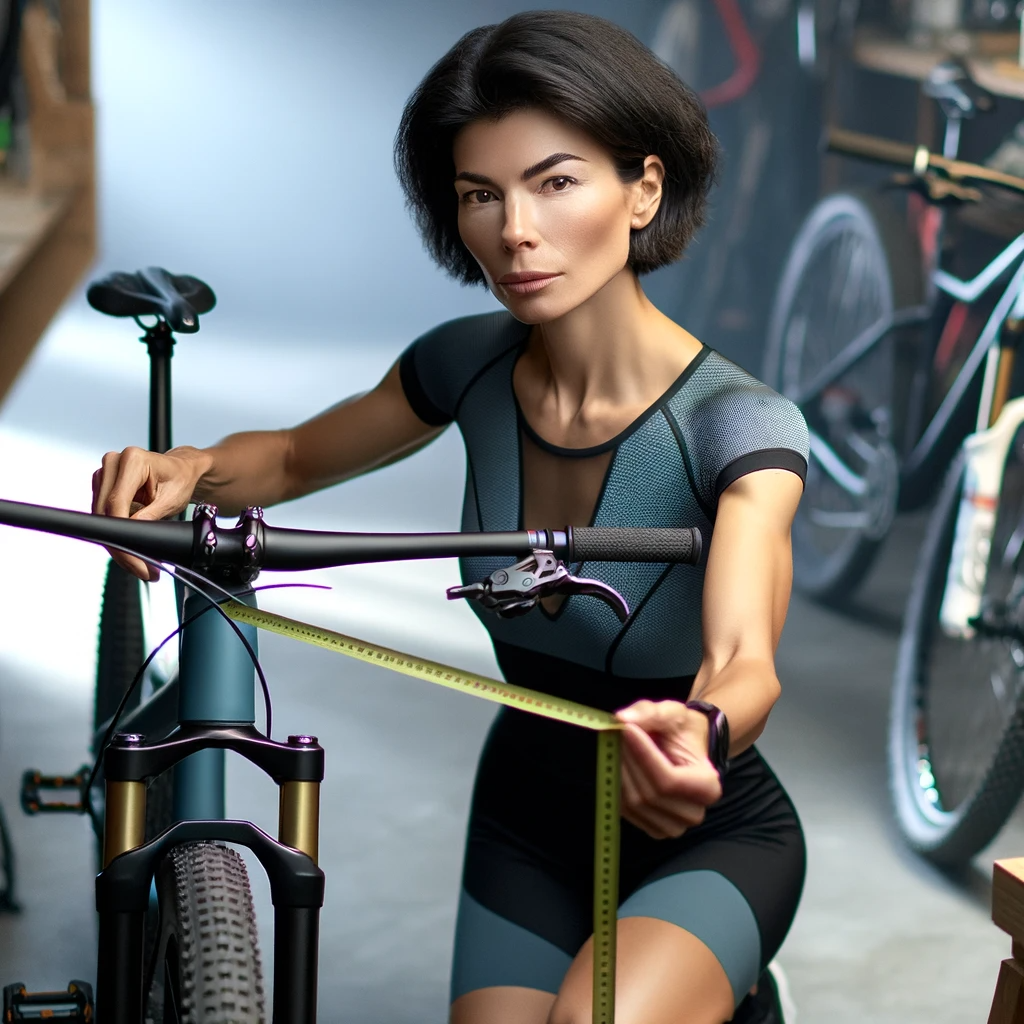As an avid mountain biker, I know how crucial it is to ensure that the bike you are riding fits you perfectly. One of the most important aspects of achieving this is to measure your MTB frame size accurately. In this section, I will provide you with a comprehensive guide on how to measure your MTB frame size accurately, step-by-step.
Key Takeaways:
- Measuring your MTB frame size accurately is essential for a comfortable and efficient ride.
- To measure your MTB frame size accurately, you will need specific tools.
- Following a step-by-step guide will help you find the perfect fit for your mountain bike.
Why Measuring MTB Frame Size Is Important
As a mountain biker, measuring your MTB frame size is one of the most crucial steps in ensuring a comfortable and efficient ride. Your MTB frame size determines how well you fit on the bike, affecting your riding position, balance, and overall control. By measuring your frame size accurately, you can avoid discomfort, back pains, and injuries caused by incorrect positioning or excessive stress on certain body parts.
Keep in mind that every mountain bike is unique, and even the slightest difference in frame size can impact your performance on the trail. Therefore, measuring your MTB frame size is not a matter of convenience but rather a necessity for your safety and well-being.
Tools Needed for Measuring MTB Frame Size
If you’re looking to measure your MTB frame size accurately, there are some specific tools you’ll need to have on hand. These include:
| Tool | Function |
|---|---|
| Tape Measure | Used to measure the distance from the center of the bottom bracket to the top of the seat tube |
| Piece of cardboard or ruler | Used to measure the distance from the center of the bottom bracket to the top of the saddle |
| A friend or partner to help | Having someone to assist you can make the measurement process easier and more accurate. |
With these tools, you’ll be able to accurately measure your MTB frame size and ensure a comfortable and efficient riding experience.
Step-by-Step Guide to Measure MTB Frame Size

Measuring your MTB frame size accurately is essential for a comfortable and efficient ride. Follow these simple steps to measure your frame size:
- Stand with your back against a wall: Wear your regular biking shoes and stand against a wall with your feet shoulder-width apart.
- Place a book between your legs: Take a book and place it between your legs, with its spine facing upwards and pressing against your crotch. Make sure the book is parallel to the ground.
- Measure the height of the book: Using a tape measure, measure the height of the book from the ground to the top of its spine. Make sure the tape measure is straight and parallel to the floor.
- Calculate your inseam length: Subtract the height of the book from your height. The resulting number is your inseam length, which will help determine your MTB frame size.
Once you have your inseam length, you can use a size chart or an online calculator to determine your ideal MTB frame size. Keep in mind that different bike brands and models may have slightly different sizing standards, so it’s crucial to consult each manufacturer’s size chart before purchasing a bike.
Now that you know how to measure your MTB frame size, you can confidently choose the right bike for your needs and preferences. Happy riding!
Tips for Choosing the Right MTB Frame Size
After measuring your MTB frame size, it’s important to choose the right size for your needs. Here are some tips to help you select the perfect frame size for your mountain bike:
- Consider your riding style: Different riding styles require different frame sizes. If you’re more into downhill riding, a larger frame may be more suitable, while cross-country riders tend to prefer a smaller frame.
- Check the manufacturer’s recommendations: Most bike manufacturers have a recommended height range for each frame size. It’s always a good idea to check this information before making your final decision.
- Test ride different sizes: If possible, test ride different frame sizes to find the most comfortable fit. This is especially important if you’re between sizes or have a unique body shape.
- Consider your flexibility: Your flexibility can also play a role in determining the right frame size. If you have limited flexibility, a smaller frame may be more comfortable, while more flexible riders may prefer a larger frame.
Conclusion
Choosing the right MTB frame size is crucial for a comfortable and efficient ride. By considering your riding style, checking manufacturer recommendations, test riding different sizes, and evaluating your flexibility, you can find the perfect fit for your mountain bike.
Common Mistakes to Avoid When Measuring MTB Frame Size
Measuring your MTB frame size accurately is crucial for ensuring a comfortable and efficient ride. However, there are some common mistakes you should avoid to achieve accurate measurements.
Mistake 1: Measuring the Seat Tube Length Only
One of the most common mistakes riders make when measuring their MTB frame size is relying solely on the seat tube length. While this measurement is essential, it is not the only factor to consider when determining frame size. Other factors to consider include top tube length, standover height, and reach.
Mistake 2: Not Wearing Your Riding Shoes
When measuring your MTB frame size, it’s essential to wear your riding shoes or shoes with a similar sole height. Failure to do so can result in inaccurate measurements, which can lead to an uncomfortable riding experience.
Mistake 3: Not Using the Correct Tools
To measure your MTB frame size accurately, you must use the correct tools, including a tape measure, a level, and a helper. Using inappropriate tools can lead to inaccurate measurements, which will affect your bike’s fit.
Mistake 4: Not Considering Your Riding Style
Another common mistake when measuring your MTB frame size is not taking your riding style into account. Different riding styles may require different frame sizes, so it’s crucial to keep your preferences in mind when making measurements.
Avoiding these common mistakes will help you measure your MTB frame size accurately. Doing so will ensure that you have a comfortable and efficient ride on your mountain bike.
Importance of Professional Bike Fitting
While measuring your MTB frame size on your own can be useful, seeking a professional bike fitting service can significantly enhance your riding experience. Professional bike fitting services are designed to help you find the perfect fit for your mountain bike by taking into account several critical factors that affect your ride.
One of the most significant advantages of seeking professional bike fitting is the access to expert knowledge and experience. Bike fitting professionals have extensive experience in analyzing your body and riding style, taking into account your specific needs and preferences. They can provide you with customized advice and recommendations that cater to your individual requirements.
Additionally, professional bike fitting services utilize specialized tools and equipment that can accurately measure your body, specifically your leg length, torso length, and reach. With this information, they can help you select the ideal size for your MTB frame, ensuring maximum comfort and efficiency.
Another benefit of professional bike fitting is the ability to make adjustments to your bike as needed. Bike fitting professionals can help you make changes to the height, angle, and position of your handlebars, seat, and pedals to optimize your comfort and performance.
In addition to enhancing your comfort and performance, professional bike fitting services can also help you avoid injury caused by a poorly fitting bike. By ensuring your bike fits you correctly, you can avoid putting unnecessary stress on your joints, muscles, and tendons.
In conclusion, seeking professional bike fitting services can significantly enhance your riding experience by providing you with expert knowledge and advice, customized recommendations, specialized tools, and equipment, and the ability to make necessary adjustments. If you are serious about improving your riding experience, consider seeking professional bike fitting services to help you find the perfect fit for your MTB frame.
Adjusting Frame Size with Bike Components
After measuring your MTB frame size, you may find that certain components affect your overall fit. These components can be adjusted to fine-tune your frame size and enhance your riding experience.
One common way to adjust frame size is by changing the stem length. A shorter stem will bring the handlebars closer to you, while a longer stem will push them further away. This can help you adjust your reach and create a more comfortable riding position.
You can also adjust your saddle position to affect your frame size. A saddle that’s too far forward can make you feel cramped, while a saddle that’s too far back can make it difficult to reach the handlebars. Finding the right saddle position can make a big difference in your overall fit.
If you need to make larger adjustments to your frame size, you can also consider swapping out your seat post or handlebars for different sizes or styles. This may require additional tools or professional assistance, but can offer a more customized fit for your bike.
It’s important to note that adjusting bike components to affect frame size should be done carefully and with the guidance of a professional if needed. Making sudden or drastic changes can affect your bike’s handling and safety, so be sure to make changes gradually and with caution.
Conclusion
In conclusion, measuring your MTB frame size is vital for a comfortable and efficient ride. By following the step-by-step guide and using the necessary tools explained in this article, you can accurately measure your frame size and avoid common mistakes. Selecting the right MTB frame size is essential for your riding needs, and seeking professional bike fitting services can enhance your overall riding experience. Remember, adjusting your frame size with bike components can also be an option if necessary. So, take your time to measure your frame size properly and choose the right MTB frame size to enjoy a smooth and enjoyable ride on your mountain bike.
FAQ
Q: Can I measure my MTB frame size on my own?
A: Yes, you can measure your MTB frame size on your own by following the step-by-step guide provided in this article.
Q: What tools do I need to measure my MTB frame size?
A: To measure your MTB frame size accurately, you will need a measuring tape, a level, and a helper to assist you.
Q: How long does it take to measure my MTB frame size?
A: The process of measuring your MTB frame size typically takes around 10-15 minutes.
Q: Can I make adjustments to my frame size using bike components?
A: Yes, certain bike components can be adjusted to fine-tune your frame size. It’s important to consult with a professional or refer to the manufacturer’s guidelines for making these adjustments.
Q: Why is professional bike fitting important?
A: Professional bike fitting can help ensure that your bike is properly adjusted to your body measurements, providing optimal comfort, efficiency, and performance.
Q: What are some common mistakes to avoid when measuring MTB frame size?
A: Common mistakes to avoid when measuring your MTB frame size include using inaccurate measurements, not considering your riding style, and not seeking professional guidance when needed.
Q: How do I choose the right MTB frame size for my needs?
A: To choose the right MTB frame size, consider factors such as your height, riding style, and personal preferences. It’s also helpful to test ride different sizes before making a decision.




